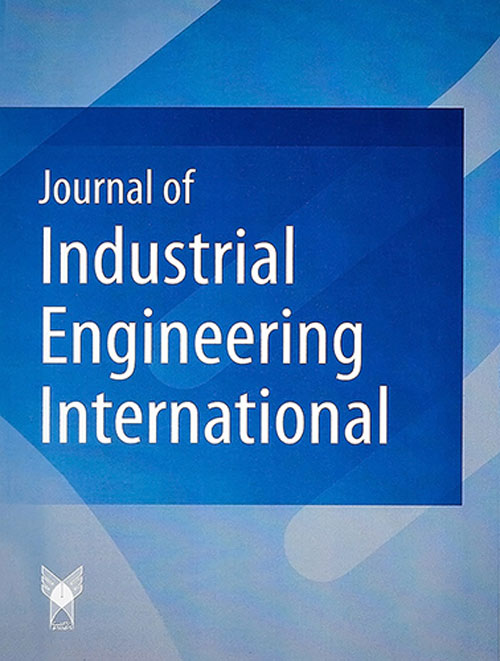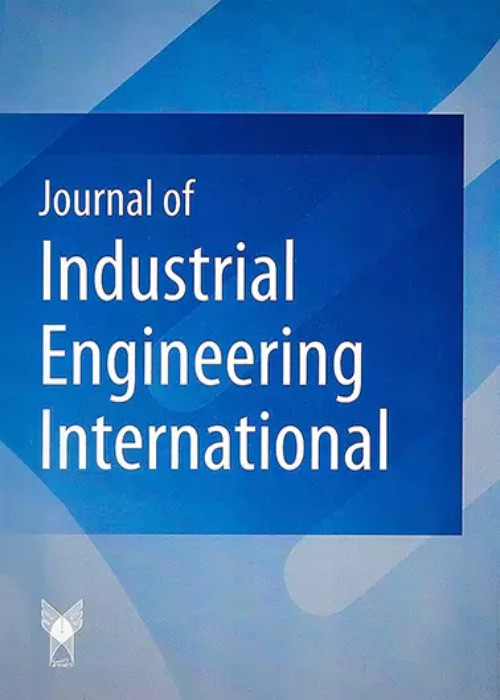فهرست مطالب

Journal Of Industrial Engineering International
Volume:17 Issue: 3, Summer 2021
- تاریخ انتشار: 1400/12/17
- تعداد عناوین: 7
-
-
Pages 1-19In this paper, a system dynamic model (SDM) has been created to predict the construction status in Iran using sustainable development indicators (SDI). The aim is to create a model based on system dynamics that would understand the complexities of the sustainable development system, as well as predict the values of variables and indicators used in the model for years to come. Since sustainable development involves various economic, social, and environmental aspects, the model has been formulated Using ten-year available data in these areas. After that, the output results of the model have been validated with reference patterns, and then, various scenarios have been created for sensitivity analysis. Finally, based on this model, the construction status in the Next years has become predictable. According to the results of this study, there is a direct and significant relationship between the amount of Construction and other indicators of sustainable development, such as the share of women working in the non-agricultural sector and the literacy rate of men aged 15-24.Keywords: Construction, Causal Loops, Sustainable Development, System Dynamics
-
Pages 20-33
This paper focuses on robust scheduling for an assembly flow shop where assembling times are uncertain. The considered manufacturing environment is a two-stage production system that consists of a processing stage followed by an assembly stage. There are two parallel machines in the first stage to process the components followed by an assembly stage wherein, the components are assembled to products. The majority of scheduling research considers a deterministic environment with pre-known and fixed data. However, in real-world condition, several kinds of uncertainties should be considered. In this article, the scheduling problem is tackle under uncertainty and the assembling time of each product at the second stage is the source of uncertainty. The problem is described and formulated as a mixed-integer linear programing model under deterministic condition. After that, the uncertainty issue is discussed and the robust scheduling procedure is introduced to minimize the maximum completion time of all products based on the min–max regret approach. To solve the robust scheduling an exact method is proposed to solve the problem on the small scales. Moreover, two approximate methods are modified and used to solve this NP-hard problem on the small and practical scales. The performances of the proposed methods are evaluated by several numerical examples taken from valid references. Computational results indicate that the proposed robust scheduling methods provide effective hedges against processing time uncertainty while maintaining excellent expected makespan performance.
Keywords: Scheduling, assembly flow shop, Uncertainty, Robustness -
Pages 34-46
Various strategies have been adopting to enhance the qualities of composites manufacturing processes to enhance achieving composite materials with precise geometry without discounting productivity. Filament winding process is considered an important method for producing composite materials for various industrial applications. Various mandrel materials are usually considered before setting the suitable type in filament winding process to ensure satisfying the desired specifications of the design requirements. This work investigated a wide range of materials that could be utilized as alternatives for the filament winding mandrels and classified materials based upon various simultaneous conflicted technical and economic standpoints. Properly optimizing and determining the most appropriate material type according to certain desired specifications via building an informative multi-criteria decision-making model would enhance both productivity and costs for composite manufacturing systems. The built model was capable of systematically selecting the most appropriate mandrel material type for the filament winding process with very limited or marginal personal selection errors. Twelve simultaneous evaluation criteria were considered. Sensitivity analysis, moreover, was conducted to reveal the reliability of the drawn conclusions.
Keywords: Composite materials, Manufacturing Processes, Optimization -
Pages 47-58The quality of a process can be described using a regression profile relationship between a response variable and some independent variables. Much research has been done on the response variables with continuous and normal distribution. While, in real situations, when a product is conforming or nonconforming on the product line, the assumption of normality is violated and a logistic regression model is used to characterize binary response variables. Also, in many cases the parameters used to design control charts for monitoring profiles are unknown and estimated by using IC reference data, which adversely influences the efficiency of control charts. In recent years, a few authors have been done on the effect of parameter estimation in monitoring profiles, especially profiles whose response variables do not follow the normal distribution. In this paper, Hotelling’s T2 chart and a multivariate exponentially weighted moving average (MEWMA) chart are used to monitor the logistic regression profile in Phase II with estimated parameters. In addition, two criteria including average of average run length (AARL) and standard deviation of average run length (SDARL) are utilized to appraise the effect of parameters estimation in Phase I on the Phase II performance of designed control charts through simulation runs. The results illustrate that the performance of these charts is significantly affected by the estimated parameters in both IC and OC conditions. Also, two methods are utilized to decrease the effect of parameters estimation which include increasing the number of reference profiles in Phase I and modifying the control limits.Keywords: Average run length, Control Chart, Logistic regression profiles, Parameters estimation, Profile monitoring
-
Pages 59-78In today’s world of technology, it is impossible to see where computer system does not play an important role. The application of distributed systems is gradually becoming broad and diverse, and as a result of this, reliability prediction is a key concern. This paper, considered a distributed system with five standby subsystems A (the clients), B (two load balancers), C (two distributed database servers), D (two mirrored distributed database serves) and E (centralized database server) is considered arranged as series-parallel system. Exponential failure and repair are susceptible for all the components of this system. Each component’s failure rates are constant and considered to obey an exponential distribution, and they are repaired using general repair or copula repair. The system is evaluated using first-order partial differential equations and the supplementary variable technique, Gumbel-Hougaard family of Copula, to find expressions for reliability metrics of system strength such as availability, reliability, MTTF, sensitivity, and profit function. These reliability metrics have been validated for different parametric values and the results are presented in tables and figures.Keywords: Availability, analysis, Distributed System, reliability, Replication
-
Pages 79-90
Exponential smoothing methods, especially Holt-Winters family, have been extensively utilized to demand time series forecasting. Previous studies show that Extended Holt Winters methods, by adding a smoothing constant to the level equation of Holt Winters methods, can improve the forecasting performance significantly. The improvements gained by the Extended Holt Winters method with additive trend motivated this research to extend this idea to the Holt Winters method with multiplicative trends too.In this paper, adding a smoothing constant to the Holt-Winters with multiplicative trend and also Holt-Winters with damped multiplicative trend was investigated, and the performance of these methods was compared with the classical methods. Quarterly and monthly time series of M3-Competition with the minimum length of ten years were used to measure the performance of proposed methods.The results showed that EHW and XHW proposed in this paper, significantly outperformed the classical Holt Winters multiplicative trend methods and can be considered by forecasters due to their better smoothing and forecasting performances.
Keywords: Holt-Winters methods, Damped trend methods, Multiplicative Trend, M3-Competition, Symmetric relative efficiency measure -
Pages 91-108The purpose of this study is to modify the EDAS method so that it can control Outlier data. In multi-criteria decision making methods, the distances between the data are the criterion for calculating the score, so the existence of significant distance of Outlier data from other data, can make the score of the criteria exclusive to Outlier data. Therefore, in addition to weighting the criteria, which is a kind of valuing the criteria relative to each other, weighting within the criteria by evaluating effective distances will be necessary. Despite the special conditions, the data distribution can be approximated to the normal distribution based on the central limit theorem. In this study, the normal distribution mechanism has been used to identify and evaluate effective distances. The proposed technique has been used for about 1950 branches of the Agricultural Bank of Iran and the results have been analyzed while comparing with the classic method.Keywords: EDAS method, data outlier, Normal distribution, central limit theorem


